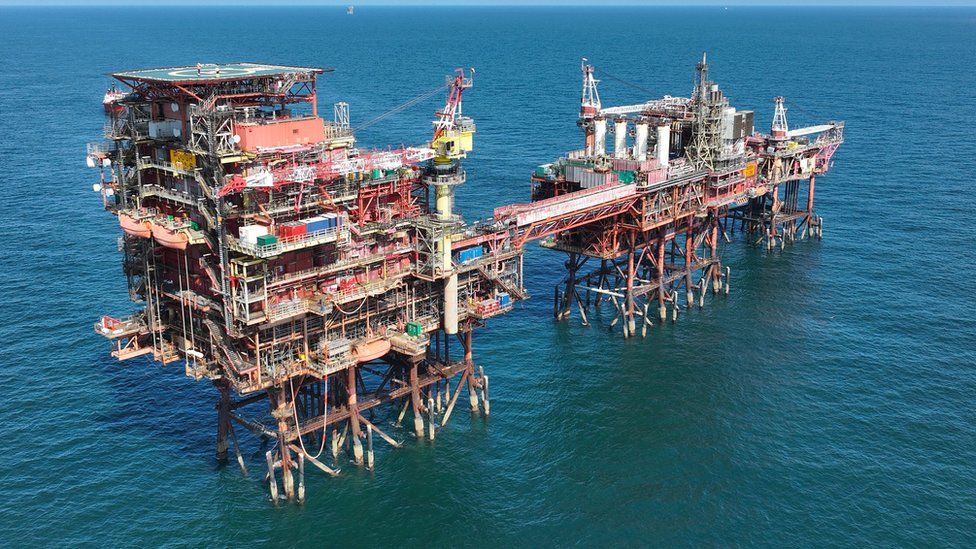What are fossil fuels? Where does the UK get its energy from?
- Published
- comments

The UK has pledged to reach "net zero" - where no additional planet-warming greenhouse gases are added to the atmosphere - by 2050.
To achieve this, much more of our energy needs to come from renewable and low-carbon sources, and much less from fossil fuels - but the government has been criticised for the lack of progress it has made.
How is the UK's energy produced?
In 2022 - the most recent full year for which data is available - the majority of the primary energy consumed within the UK (78.4%) came from coal, oil and gas, known as fossil fuels.
That is down from 87.2% in 2012, mainly due to the declining use of the dirtiest fossil fuel, coal.
"Primary" energy refers to fuels in their raw form, before they are converted into "useful" energy which heats and powers homes, businesses, transport and industry. The amount of useful energy produced is often much less than the amount of primary energy put in, particularly with fossil fuels.
Around one-fifth (20.7%) of UK primary energy consumption was from "low-carbon" sources in 2022 - up from 12% in 2012.
"Low-carbon" includes renewables such as wind, solar, hydropower and bioenergy, as well as nuclear.
Nuclear is not renewable, but is classed as low-carbon because power stations do not directly release greenhouse gases during their operation.
The output from nuclear energy has actually fallen by around a third in the past decade due to ageing reactors.
How does the UK produce its electricity?
Electricity generation accounted for around a third of the UK's total fuel usage in 2022.
Of the electricity generated in the UK in 2022:
- 40.8% came from fossil fuels
- 56.2% from low-carbon sources, including 41.5% from renewables and 14.7% from nuclear
By comparison, for electricity generated in 2012:
- 67.6% came from fossil fuels
- 30.7% came from low-carbon sources, including 11.3% from renewables and 19.3% from nuclear.
Power generation from coal has fallen sharply, although natural gas usage remains high.
The use of both wind and solar power has increased rapidly. In the first three months of 2023, wind generated more electricity than gas.
How is the UK reducing carbon emissions from energy?
To meet the UK's legally-binding target to be net zero across the economy by 2050, the government has said that all electricity should be generated from "clean" sources by 2035.
All remaining non-electric energy use will have to be net zero by 2050.
Because electricity can be generated by low-carbon sources rather than fossil fuels, demand for it is expected to grow by 40-60% by 2035 - for example as heating and transport systems become more electrified.
Ensuring electricity is generated as cleanly as possible will therefore be increasingly important to meet the overall net zero goal.
To achieve this, the government has announced ambitious targets to increase the capacity of offshore wind, nuclear, carbon capture and hydrogen.
Is the government doing enough?
Reports by the government's independent climate advisers the Climate Change Committee (CCC), the National Audit Office and a cross-party group of MPs have all warned that the UK risks missing its 2035 "clean" electricity target if it fails to take more rapid action.
Key recommendations include:
- reducing natural gas usage more quickly
- improving homes' energy efficiency
- changing planning laws to speed up renewable projects
- reforming the electricity grid to pass on the cheaper running costs of renewables to consumers
How much of the UK's energy is imported?
In 2022, the UK imported about 37% of its primary energy.
That represents a drop from nearly 50% in the early 2010s, but the figure is still higher than in the late 1990s, when the UK was a net exporter - sending more energy abroad than it imported.
The UK imports proportionally less of its electricity - typically about 5%.
What about energy security?
The importance of energy security was highlighted when Russia's invasion of Ukraine disrupted the gas market.
The reduction in Russian supplies caused global energy prices to soar, and pushed up consumer bills in the UK.
The government argues that new UK oil and gas production will help "secure our domestic energy supply and reduce reliance on hostile states".
In March, Prime Minister Rishi Sunak said the UK needs to build new, gas-fired power stations to replace existing plants, many of which are aging and will soon be retired.
The government did not give any details about when, or where, the new power stations would be built, but confirmed the plans do not include carbon capture measures.
The Green Alliance think tank said the announcement "flies in the face" of the commitment to reach zero-carbon electricity by 2035.
It follows an announcement in July 2023 declaring 100 new North Sea oil and gas licences would be awarded.
Production at the UK's largest undeveloped oil and gas field, Rosebank, was approved in September, and may begin in late 2026.
The Climate Change Committee, along with Green Alliance and the Energy and Climate Intelligence Unit, argue that investing in renewables would be the most effective way to lower bills for customers and boost energy security, by reducing demand for fossil fuel imports.
The government's climate advisers warned, in June 2023, that the "expansion of fossil fuel production is not in line with net zero" commitments.
The International Energy Agency says "there is no need for investment in new coal, oil and gas", and that new projects put international climate agreements at risk.